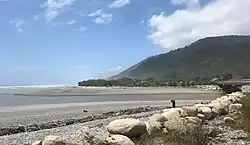Hector and Ngakawau | |
|---|---|
 Ngākawau River mouth | |
| Coordinates: 41°36′23″S 171°52′50″E / 41.60639°S 171.88056°E | |
| Country | New Zealand |
| Region | West Coast |
| District | Buller District |
| Ward | Seddon |
| Electorates | |
| Government | |
| • Territorial Authority | Buller District Council |
| • Regional council | West Coast Regional Council |
| • Mayor of Buller | Jamie Cleine |
| • West Coast-Tasman MP | Maureen Pugh |
| • Te Tai Tonga MP | Tākuta Ferris |
| Area | |
| • Total | 2.53 km2 (0.98 sq mi) |
| Population (June 2023)[2] | |
| • Total | 190 |
| • Density | 75/km2 (190/sq mi) |
Hector and Ngakawau are two lightly populated settlements located at the mouth of the Ngākawau River in the West Coast region of New Zealand. Both settlements are situated on State Highway 67 between Westport and Karamea. Despite a low population, many of the workers at New Zealand's largest open-cut coal mine at Stockton choose to live at these places and shuttles frequently operate between the two places.
Hector
Hector sits on the northern side of the Ngākawau River's mouth, and is the more populous of the two settlements.
Hector has adopted the endangered Hector's dolphin as a town icon and is involved in Department of Conservation projects to protect the dolphin.[3] The dolphins often play just offshore from Hector and attract visitors. Another local attraction is a country music museum.[4]
Ngakawau
Ngakawau, the more economically important of the two settlements, stands on the southern side of the mouth of the Ngākawau River.
As of 2015 Ngakawau serves as the terminus of the Ngakawau Branch railway. An aerial ropeway from the Stockton Mine transports significant tonnages of coal to Ngakawau for trans-shipment to the port town of Lyttelton on the east coast of New Zealand. The line from Westport to Ngakawau opened on 12 September 1877, and an extension northward across the river through Hector to Mokihinui opened on 8 August 1893. The line ultimately extended to Seddonville on 23 February 1895 and became known as the Seddonville Branch. Passenger services through both settlements were provided by mixed trains; they ceased to operate from 14 October 1946. Coal was almost the sole traffic from that stage, and as output from mines to the north declined, the line's maintenance costs outweighed revenue and the section north of Ngakawau closed.[5][6]
Demographics
Ngakawau is described by Statistics New Zealand as a rural settlement and covers 2.53 km2 (0.98 sq mi), including Hector.[1] Hector and Ngakawau had an estimated population of 190 as of June 2023,[2] with a population density of 75 people per km2. It is part of the larger Buller Coalfields statistical area.[7]
| Year | Pop. | ±% p.a. |
|---|---|---|
| 2006 | 231 | — |
| 2013 | 222 | −0.57% |
| 2018 | 198 | −2.26% |
| Source: [8] | ||

Hector and Ngakawau had a population of 198 at the 2018 New Zealand census, a decrease of 24 people (−10.8%) since the 2013 census, and a decrease of 33 people (−14.3%) since the 2006 census. There were 114 households, comprising 105 males and 96 females, giving a sex ratio of 1.09 males per female, with 18 people (9.1%) aged under 15 years, 15 (7.6%) aged 15 to 29, 105 (53.0%) aged 30 to 64, and 57 (28.8%) aged 65 or older.
Ethnicities were 92.4% European/Pākehā, 18.2% Māori, 1.5% Pasifika, and 1.5% other ethnicities. People may identify with more than one ethnicity.
Although some people chose not to answer the census's question about religious affiliation, 59.1% had no religion, 24.2% were Christian, 1.5% were Buddhist and 1.5% had other religions.
Of those at least 15 years old, 12 (6.7%) people had a bachelor's or higher degree, and 66 (36.7%) people had no formal qualifications. 6 people (3.3%) earned over $70,000 compared to 17.2% nationally. The employment status of those at least 15 was that 51 (28.3%) people were employed full-time, 18 (10.0%) were part-time, and 9 (5.0%) were unemployed.[8]
Notes and references
Notes
- 1 2 "ArcGIS Web Application". statsnz.maps.arcgis.com. Retrieved 2 August 2023.
- 1 2 "Subnational population estimates (RC, SA2), by age and sex, at 30 June 1996-2023 (2023 boundaries)". Statistics New Zealand. Retrieved 25 October 2023. (regional councils); "Subnational population estimates (TA, SA2), by age and sex, at 30 June 1996-2023 (2023 boundaries)". Statistics New Zealand. Retrieved 25 October 2023. (territorial authorities); "Subnational population estimates (urban rural), by age and sex, at 30 June 1996-2023 (2023 boundaries)". Statistics New Zealand. Retrieved 25 October 2023. (urban areas)
- ↑ Mike Copeland, "Conservation with West Coast Communities" Archived 30 September 2007 at the Wayback Machine, accessed 24 June 2007.
- ↑ Tourism West Coast, "Granity / Ngakawau / Hector", accessed 24 June 2007.
- ↑ David Leitch and Brian Scott, Exploring New Zealand's Ghost Railways, rev. ed. (Wellington: Grantham House, 1998), 52–3.
- ↑ Churchman & Hurst 2001, p. 192.
- ↑ 2018 Census place summary: Buller Coalfields
- 1 2 "Statistical area 1 dataset for 2018 Census". Statistics New Zealand. March 2020. 7023591 and 7023593.
References
- Churchman, Geoffrey B; Hurst, Tony (2001) [1990, 1991]. The Railways of New Zealand: A Journey through History (Second ed.). Transpress New Zealand. ISBN 0-908876-20-3.